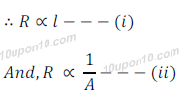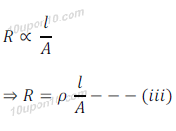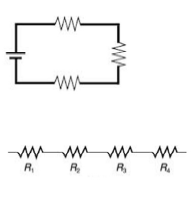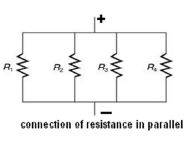Electricity - Class 10th Science
Resistance
A conductor allows the electric current to flow through it, but it does not allow the electric current to flow from it easily. There is a property of conductor which resists the flow of electric current.
This property of a conductor which resists the flow of electric current through it is called RESISTANCE of material. Resistance is a characteristic property of the material.
Resistance is generally denoted by letter 'R'.
According to Ohm's Law the resistance is the ratio of potential difference and electric current passing through the conductor.
Or, Resistance (R)


SI Unit of Resistance
SI unit of resistance is ohm.
Ohm is denoted by Greek letter Omega (Ω).
Omega got its name in the honour of Georg Ohm.
The SI unit of potential difference is V (volt).
The SI unit of electric current is A (ampere).
We know that,

By substituting the SI unit of potential difference and SI unit of electric current in the expression of Ohm's Law we get,

If a potential difference equal to 1V is required for the flow of electric current of 1A, then the resistance or resistivity is equal to 1 ohm.
This means,

Nature of Conductor on which Resistance depends
Resistance depends on the following properties of a conductor:
(a) Length of the conductor
(b) Area of cross section i.e. thickness of a conductor
(c) Nature of the material of a conductor.
Experiments show that
Resistance of a uniform metallic conductor is directly proportional to its length (l) and inversely proportional to the area of cross section (A).

By combining, expression (i) and (ii) we get,

Where, ρ (rho) is a proportionality constant. It is called the electrical resistivity of the material of the conductor.
According to expression (iii) it is clear that:
Resistance increases with increase in length of a conductor and decreases with decrease in the length of the conductor.
Resistance decreases with increases in thickness of a conductor and increases with decrease in thickness of a conductor.
SI Unit of Resistivity
The SI unit of Resistivity is ohm meter (Ω m)
Cause of resistance or resistivity
When a foot-ball is kicked, it starts moving and stops after reaching a certain distance. Foot-ball stops because of friction between foot-ball and ground. Friction creates hindrance in moving of ball.
Similarly, electric current has to face hindrance when it flows through a conductor.
All substances are made of small particles called atoms. Atoms are composed of electrons, protons and neutrons. Flow of electric charge is nothing but flow of electrons through a conductor.
When electric current, i.e. electrons, flows through a conductor, the constituent particles of conductor create hindrance in the flow of electrons because they attract each other. This hindrance is the cause of resistance in the flow of electric current.
Conductors: All substances do not allow the flow of electric current through them. Materials that allow the passage of electric current through them are known as conductor. This means, materials that create low resistance in the flow of electric current through them are called good conductors.
Examples: Copper, silver, gold, iron, aluminium, etc. are good conductor of electricity.
Silver is the best conductor of electricity. Copper and aluminium also do not create much resistance in the flow of electricity, and thus are also very good conductors. This is the cause that electric wires are made of copper or aluminium. Silver is very costly, so it is not used for making electric wires. Electricity is transported to our household through aluminium wire because of its good conductivity.
Bad conductor and Insulator
Materials that do not allow the flow of electric current through them are called BAD CONDUCTOR. For example: rubber, plastic, wood, etc. These materials produce high resistance in the flow of electricity through them.
Materials which create very high resistance and prevent the flow of electricity through them are called INSULATORS.
There is no perfect insulator. This means there is no material that can completely restrict the flow of electric current. However, the resistance or hindrance is so high in some materials that this almost prevents the flow of electricity through them.
Example: Glass, paper and Teflon, etc. have resistivity of electric current high enough, and are used as insulator. Rubber, plastic, etc. and many other materials have good enough resistivity so that they can be used to insulate electrical wiring and cables.
The cover of an electric wire is made of plastic or rubber. Electric switch and plugs are made of plastic to prevent the flow of electricity through them. These covers protect us from getting electric shock during use. Ceramic discs are used in transmission line to prevent the flow of electric current to the poles.
Resistivity and Good Conductor and Insulators
Substances which have resistivity in the range of 10–8 Ωm to 10–6 Ωm are good conductor of electricity. Metals and their alloys have resistivity in the range of 10–8 Ω m to 10–6 Ωm.
Substances which have resistivity in the range of 1010 Ωm to 1017 Ωm are called the Insulators. Rubber and glass are very good insulators and have resistivity in the range of 1012 Ωm to 1017 Ωm.
Resistivity of Alloys
Alloys have generally high electrical resistivity than that of pure metal. On the other hand alloys do not burn (oxidise) readily on high temperature. This is the cause that metals alloy are used in electrical heating devices, such as iron, toaster, heater, etc.
Example: Tungusten is used as filament of electric bulbs because it has high resistivity whereas aluminium and copper are used in electric wires because aluminium and copper has low resistivity.
Combination of electrical components in electric circuit
Electrical components are connected or combined in electric circuit in following two ways:
- In series circuit
- In parallel circuit
Combination of electrical components in series
When electrical components, such as bulb, resistors, electric cells, etc. are combined end to end in an electric circuit, the combination is known as combination in series circuit.

When electrical components are combined in series, i.e. from end to end the same electric current flows through all of the components. This means the flow of electric current remains the same in all of the components combined in series.
Whereas voltage supplied through the series circuit is divided among all the components connected in series.
Thus, when electrical components are connected in series
(a) Flow of electric current remains same to the all of the components connected in series.
(b) Voltage (potential difference) is divided among all of the components connected in series.
Example: Series bulbs used in decoration in marriage or other functions are generally connected in series.
The decorative bulbs are connected in series; in order to divide the potential difference in low voltage bulbs.
Combination of component in parallel in electric circuit
When more than one electrical components are connected in an electric circuit so that the negative pole of all of the electrical components are connected to negative terminal of electricity and positive poles of all the components are connected to positive terminal of the electricity, the combination is called parallel in electric circuit.

In parallel combination of electrical components in electric circuit
(a) There is no division of voltage (potential difference) among electrical components connected in parallel.
(b) Flow of electric current is divided among the electrical components connected in parallel electric circuit.
Example: In households all of the electrical components, such as bulbs, electrical fans, etc. are connected in parallel circuit.
Electrical components are connected in parallel in households in electric circuit to prevent the division of potential difference among components.